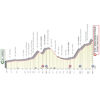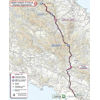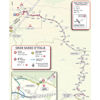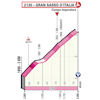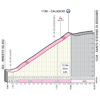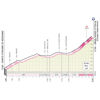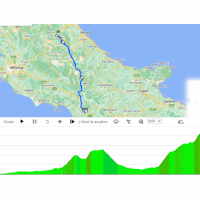Five years ago, the Giro re-visited the Gran Sasso after a long hiatus. In the distant past, first riders at the massif in Abruzzo were Marco Pantani (1999), John Carlsen (1989), Franco Chioccioli (1985), and Vicente López Carril (1971). In 2018, it was Simon Yates who took the spoils.
The full name of the mountain range is Gran Sasso d’Italia, which is appropriate as it means Great Stone of Italy. The Gran Sasso is dominated by three peaks: Corno Grande, Corno Piccolo and Pizzo Intermesoli. At 2,912 metres, Corno Grande is the highest peak in the Apennines.
The riders don’t go that high, but a finish at 2,135 metres above sea level is still impressive. There is 5% less oxygen available at that altitude.
The route starts to climb after a flat prelude of almost 70 kilometres. The Rionero Sannitico is an ascent of 14 kilometres with an average gradient of 4.6%. Following a short descent and a flat section the next climb goes to Roccaraso. This is a 8.9 kilometres test at 6.2% with its steepest ramp at 12%.
Following the passage in Roccaraso the route continues on the flat for 10 kilometres before a long stretched descent runs to the foot of the ascent to Calascio. At 13.7 kilometres this climb is averaging 6%. The almost abandoned village is dominated by Rocca Calascio, an impressive mountaintop fortress at 1,460 metres.
Arguably, the last climb begins at the foot of the Calascio climb, with 47 kilometres remaining. After moving through the village the route remains on the flat for 5.6 kilometres and then it goes back up again. By now, the riders are on the final ascent to the Campo Imperatore – or, Emperor’s Field – of the Gran Sasso. This is the largest plateau of the Apennine ridge.
The actual last climb of the 7th stage opens with 10 kilometres at 4% before a rolling false flat of 9 kilometres followed by 3 kilometres at 4.1%. Then the Gran Sasso starts to show its teeth. The last 4.5 kilometres to the Campo Imperatore go up at 8.2%, while the steepest ramp of 13% appears 1.5 kilometres before the finish line.
The second intermediate sprint comes with time bonuses of 3, 2 and 1 seconds, while 10, 6 and 4 seconds are awarded to the first three riders on the line.
Ride the route yourself? Download GPX stage 7 2023 Giro d’Italia.
Another interesting read: results 7th stage Giro 2023.
Giro d’Italia 2023 stage 7: route, profile, more
Click on the images to zoom
